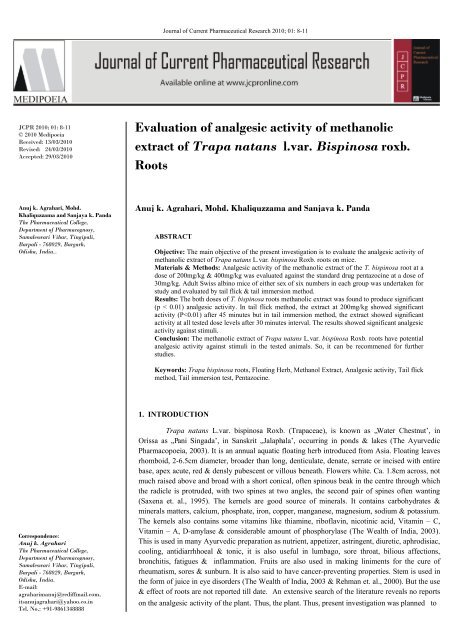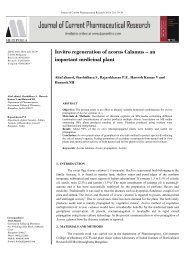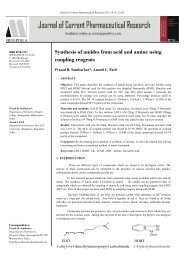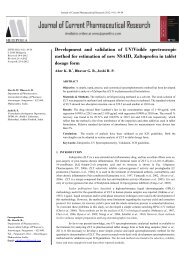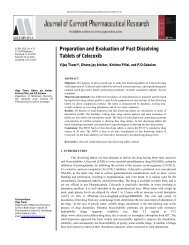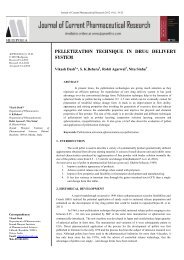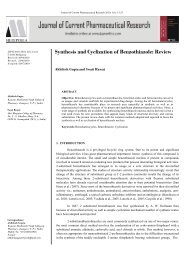Evaluation of analgesic activity of methanolic extract of Trapa natans ...
Evaluation of analgesic activity of methanolic extract of Trapa natans ...
Evaluation of analgesic activity of methanolic extract of Trapa natans ...
Create successful ePaper yourself
Turn your PDF publications into a flip-book with our unique Google optimized e-Paper software.
Journal <strong>of</strong> Current Pharmaceutical Research 2010; 01: 8-11<br />
JCPR 2010; 01: 8-11<br />
© 2010 Medipoeia<br />
Received: 13/03/2010<br />
Revised: 24/03/2010<br />
Accepted: 29/03/2010<br />
<strong>Evaluation</strong> <strong>of</strong> <strong>analgesic</strong> <strong>activity</strong> <strong>of</strong> <strong>methanolic</strong><br />
<strong>extract</strong> <strong>of</strong> <strong>Trapa</strong> <strong>natans</strong> l.var. Bispinosa roxb.<br />
Roots<br />
Anuj k. Agrahari, Mohd.<br />
Khaliquzzama and Sanjaya k. Panda<br />
The Pharmaceutical College,<br />
Department <strong>of</strong> Pharmacognosy,<br />
Samaleswari Vihar, Tingipali,<br />
Barpali - 768029, Bargarh,<br />
Odisha, India..<br />
Anuj k. Agrahari, Mohd. Khaliquzzama and Sanjaya k. Panda<br />
Sathesh B. P. R, Goli Divakar, Manoj K. Jangid and Kapil K. Purohit<br />
ABSTRACT<br />
Objective: The main objective <strong>of</strong> the present investigation is to evaluate the <strong>analgesic</strong> <strong>activity</strong> <strong>of</strong><br />
<strong>methanolic</strong> <strong>extract</strong> <strong>of</strong> <strong>Trapa</strong> <strong>natans</strong> L.var. bispinosa Roxb. roots on mice.<br />
Materials & Methods: Analgesic <strong>activity</strong> <strong>of</strong> the <strong>methanolic</strong> <strong>extract</strong> <strong>of</strong> the T. bispinosa root at a<br />
dose <strong>of</strong> 200mg/kg & 400mg/kg was evaluated against the standard drug pentazocine at a dose <strong>of</strong><br />
30mg/kg. Adult Swiss albino mice <strong>of</strong> either sex <strong>of</strong> six numbers in each group was undertaken for<br />
study and evaluated by tail flick & tail immersion method.<br />
Results: The both doses <strong>of</strong> T. bispinosa roots <strong>methanolic</strong> <strong>extract</strong> was found to produce significant<br />
(p < 0.01) <strong>analgesic</strong> <strong>activity</strong>. In tail flick method, the <strong>extract</strong> at 200mg/kg showed significant<br />
<strong>activity</strong> (P
Journal <strong>of</strong> Current Pharmaceutical Research 2010; 01: 8-11<br />
find out the therapeutic level <strong>of</strong> <strong>methanolic</strong> <strong>extract</strong> <strong>of</strong> <strong>Trapa</strong> <strong>natans</strong><br />
L.var. bispinosa Roxb. roots in <strong>analgesic</strong> <strong>activity</strong>.<br />
2. MATERIALS AND METHODS<br />
<strong>Trapa</strong> <strong>natans</strong> L.var.bispinosa Roxb. roots were collected<br />
from the lake <strong>of</strong> village “Bhaisatara” in Raipur district <strong>of</strong><br />
Chhattisgarh. The plant material was authenticated from Botanical<br />
Survey <strong>of</strong> India, Howrah, Kolkata (No. CNH/ I – I (5)/ 2009/ Tech.<br />
II / 35). Few authentic samples were preserved in department <strong>of</strong><br />
Pharmacognosy, The Pharmaceutical College, Barpali for future<br />
reference.<br />
After authentication, fresh plant material was collected in<br />
bulk, washed under running tap water to remove adhering material,<br />
dried under shade and pulverized in a mechanical grinder. The<br />
coarse powder was pass through sieve no. 40 and taken for further<br />
studies.<br />
Preparation <strong>of</strong> Extract<br />
For the preparation <strong>of</strong> <strong>extract</strong> 100gm <strong>of</strong> dried coarse<br />
powdered roots were charged in to the soxhlet‟s apparatus (hot<br />
<strong>extract</strong>ion) and <strong>extract</strong>ed successively with petroleum ether (60 0 -<br />
80 0 C), chlor<strong>of</strong>orm, ethyl acetate & methanol, in order <strong>of</strong> their<br />
increasing polarity.<br />
The successive <strong>methanolic</strong> <strong>extract</strong> (deep brown colour)<br />
was filtered & dried under reduced pressure to get a solid mass free<br />
from the solvent. The yield was 5.9% with respect to dry starting<br />
material with characteristic odour & greasy consistency. The dried<br />
<strong>extract</strong> was dissolved in solution <strong>of</strong> 2% gum acacia in distilled<br />
water (vehicle) for the evaluation <strong>of</strong> <strong>analgesic</strong> <strong>activity</strong>.<br />
Animals Used<br />
Adult albino rats weighing between 150 – 200gm and<br />
Adult swiss albino mice weighing between 25 – 30gms <strong>of</strong> either<br />
sex were used for the studies. The animals were maintained under<br />
normal laboratory condition & kept in standard polypropylene<br />
cages at room temperature <strong>of</strong> 30 0 ±2 0 and 60 to 65% relative<br />
humidity and provided with standard diet & water ad libitum.<br />
The experimental protocols were approved by institutional<br />
Animal Ethical Committee & a written permission from in house<br />
ethical committee has been taken to carry out (Reference no.<br />
PCB/AEC/04/09 on dated 23 rd April, 2009) and complete this<br />
study.<br />
Toxicity Study<br />
The selected adult albino rats were used to determine the<br />
dose. The animals were divided in to eight groups <strong>of</strong> six in each.<br />
The animals were fasted overnight prior to the acute experimental<br />
procedure. The karber‟s method (Ghosh et. al., 2005 & Kale et. al.,<br />
2005) was used to determine the dose; gum acacia (2% w/v) was<br />
used as vehicle to suspend the <strong>extract</strong>s and administered<br />
intraperitoneally. The control group received 2ml/kg <strong>of</strong> the vehicle<br />
intraperitoneally. The other group received the <strong>extract</strong> as test drug<br />
in one <strong>of</strong> the following doses – 100, 200, 400, 800, 1000, 2000 and<br />
3000mg/kg in a similar manner. Immediately after dosing, the<br />
animals were observed continuously for first four hours for<br />
behavioral changes and for mortality at the end <strong>of</strong> 24hrs, 48hrs and<br />
72hrs respectively. The toxicity study showed that the <strong>methanolic</strong><br />
<strong>extract</strong> <strong>of</strong> drug at a minimum dose <strong>of</strong> 200mg/kg onwards shows the<br />
reaction in experimental animals. However, no mortality was<br />
reported even after 72hours. This indicates that the <strong>methanolic</strong><br />
<strong>extract</strong> is safe up to a single dose <strong>of</strong> 3g/kg body weight.<br />
Table 1. Analgesic <strong>activity</strong> <strong>of</strong> <strong>Trapa</strong> bispinosa Roxb. by Tail Flick Method<br />
Group Treatment Dose<br />
Basal Reaction<br />
Time (Sec)<br />
Reaction Time (Sec)<br />
15 min 30 min 45 min 60 min<br />
I 2% w/v Gum acacia 2ml/kg 2.50 ± 0.33 2.80 ± 0.21 2.90 ± 0.21 3.10 ± 0.19 2.60 ± 0.15<br />
II Pentazocine 10mg/kg 2.60 ± 0.28 4.10 ± 0.41 * 5.50 ± 0.39 ** 6.93 ± 0.72** 8.26 ± 0.59**<br />
III Test Drug – I 200mg/kg 2.80 ± 0.23 3.70 ± 0.24* 4.60 ± 0.20 * 5.70 ± 0.54** 7.26 ± 0.49**<br />
IV Test Drug - II 400mg/kg 2.40 ± 0.25 3.90 ± 0.33* 5.00 ± 0.23** 6.20 ± 0.43** 7.60 ± 0.56**<br />
Result expressed as mean ± SEM from six observations; ** indicates P < 0.01 & * indicates P < 0.05<br />
9
Journal <strong>of</strong> Current Pharmaceutical Research 2010; 01: 8-11<br />
Table 2. Analgesic <strong>activity</strong> <strong>of</strong> <strong>Trapa</strong> bispinosa Roxb. by Tail immersion Method<br />
Group Treatment Dose<br />
Basal Reaction<br />
Time (Sec)<br />
Reaction Time (Sec)<br />
15 min 30 min 45 min 60 min<br />
I 2% w/v Gum acacia 2ml/kg 2.00 ± 0.33 2.40 ± 0.19 2.54 ± 0.19 2.60 ± 0.19 2.16 ± 0.15<br />
II Pentazocine 10mg/kg 2.43 ± 0.19 4.10 ± 0.41 * 5.60 ± 0.31 ** 7.00 ± 0.23 ** 8.50 ± 0.21 **<br />
III Test Drug - I 200mg/kg 2.18 ± 0.15 3.58 ± 0.19* 4.60 ± 0.21 ** 6.10 ± 0.23** 7.20 ± 0.57 **<br />
IV Test Drug - II 400mg/kg 2.62 ± 0.36 3.84 ± 0.28 * 4.90 ± 0.43** 6.60 ± 0.42** 7.80 ± 0.45 **<br />
Result expressed as mean ± SEM from six observations; ** indicates P < 0.01 & * indicates P < 0.05<br />
Analgesic Activity (Kulkarni et. al., 1993, Ghosh et. al., 2005 &<br />
Geetha et. al., 2004)<br />
Tail flick method<br />
Before the study, Swiss albino mice were screened for<br />
sensitivity test by placing the tip <strong>of</strong> the tail on the radiant heat<br />
source. Any animals that held to withdraw its tail in 5 second was<br />
rejected from the study. The selected animals were divided into<br />
four groups <strong>of</strong> six rats each. Each animals <strong>of</strong> the groups received<br />
one <strong>of</strong> the following <strong>extract</strong> (200mg/kg & 400mg/kg), Pentazocine<br />
(30mg/kg) and 2% w/v <strong>of</strong> Gum acacia (2ml/kg) in normal saline<br />
intraperitoneally. Analgesia was assessed with a tail flick apparatus<br />
(Analgesiometer). The basal reaction time was measured initially<br />
and another set <strong>of</strong> four measures were taken as 15, 30, 45 and 60<br />
minutes interval and the reaction <strong>of</strong> the animals considered as the<br />
post – drug reaction time. A cut-<strong>of</strong>f period <strong>of</strong> 10sec. was observed<br />
to prevents tissue damage <strong>of</strong> the tail <strong>of</strong> the animals. The results are<br />
tabulated in table. no.1.<br />
Tail immersion Test<br />
Prior to <strong>analgesic</strong> experiments, the animals were screened<br />
for the sensitivity test by immersing the tail <strong>of</strong> the mice gently in<br />
hot water maintained at 55 0 C – 55.5 0 C . The animal immersing<br />
the tail from hot water with in 5 second was selected for the study.<br />
The selected rat was then divided in to four groups <strong>of</strong> six rats each.<br />
Group III & Group IV received the <strong>extract</strong> in 2 % w/v Gum acacia<br />
in normal saline intraperitoneally at a dose <strong>of</strong> 200mg/kg &<br />
400mg/kg respectively. Group II received Pentazocine (30mg/kg)<br />
and Group I received 2% w/v <strong>of</strong> Gum acacia (2ml/kg) in normal<br />
saline manner. After administration <strong>of</strong> the drugs, the reaction time<br />
was measured at 0, 15, 30, 45 and 60 minutes. The results are<br />
tabulated in table. no. 2.<br />
Statistical Analysis<br />
The mean value ± SEM was calculated for each<br />
parameter. The results were analyzed statistically by ANOVA is<br />
followed by Dunnet‟s test. The minimum level <strong>of</strong> significant was<br />
fixed at p < 0.01.The results <strong>of</strong> experiments by proper statistical<br />
analysis are tabulated in table. No.1 and 2 respectively.<br />
3. RESULTS AND DISCUSSION<br />
In <strong>analgesic</strong> studies, the <strong>extract</strong> showed significant<br />
<strong>analgesic</strong> <strong>activity</strong> at all tested dose levels. In tail flick method, the<br />
<strong>methanolic</strong> <strong>extract</strong> <strong>of</strong> T. bispinosa root at a dose <strong>of</strong> 200mg/kg<br />
showed significant <strong>activity</strong> (5.7 ± 0.549**) (P < 0.01) after 45<br />
minutes whereas at a dose <strong>of</strong> 400mg/kg showed significant<br />
<strong>analgesic</strong> <strong>activity</strong> (5.0 ± 0.235**) after 30 minutes (table. no. 1)<br />
but in tail immersion method, the <strong>methanolic</strong> <strong>extract</strong> <strong>of</strong> T.<br />
bispinosa root showed significant <strong>activity</strong> after 30 minutes interval<br />
<strong>of</strong> experiment at all tested dose levels (table no. 2). The results<br />
showed significant <strong>analgesic</strong> <strong>activity</strong> against thermal stimuli.<br />
The <strong>analgesic</strong> studies revealed that the <strong>methanolic</strong> <strong>extract</strong><br />
<strong>of</strong> T. bispinosa roots exhibited potent <strong>analgesic</strong> (central <strong>analgesic</strong><br />
<strong>activity</strong>) effect against thermal noxious stimuli (Vogel et. al., 2002)<br />
and also revealed that the <strong>extract</strong> shows dose dependent <strong>analgesic</strong><br />
effect.<br />
4. CONCLUSION<br />
From the above investigation, it is quite apparent that<br />
<strong>methanolic</strong> <strong>extract</strong> <strong>of</strong> <strong>Trapa</strong> <strong>natans</strong> L.var. bispinosa Roxb. roots<br />
possesses potent <strong>analgesic</strong> effect against different stimuli. This is<br />
evidenced by significant increase in the reaction time by stimuli in<br />
different experimental models.<br />
10
Journal <strong>of</strong> Current Pharmaceutical Research 2010; 01: 8-11<br />
ACKNOWLEDGEMENTS<br />
The Authors are grateful to extend special thanks to Mr.<br />
R.L. Hota, Chairman, G.B <strong>of</strong> The Pharmaceutical College, Barpali<br />
for his constant encouragement & support throughout the work.<br />
The authors are extend sincere thanks to Mr. N.K. Hota, President<br />
& Mr. S.K.Sahu, Secretary <strong>of</strong> The Pharmaceutical College, Barpali<br />
for providing all kind <strong>of</strong> facilities for this work.<br />
REFERENCES<br />
Chandra D, Analgesic effect <strong>of</strong> aqueous and alcoholic <strong>extract</strong> <strong>of</strong> Madhuka<br />
longifolia, Indian J. <strong>of</strong> Pharmacology, 2001; 33:108-111.<br />
Geetha M, Saluja, Shankar AK, Mehta RS, Analgesic and antiinflammatory <strong>activity</strong><br />
<strong>of</strong> Couroupita guianensis Aubl, J. <strong>of</strong> Natural Remedies,2004; 4(1): 52-<br />
55.<br />
Ghosh MN, <strong>Evaluation</strong> <strong>of</strong> Analgesic <strong>activity</strong>. In:Fundamentals <strong>of</strong> experimental<br />
pharmacology, 2 nd ed., Scientific book Agency,Calcutta, (2005) 69-71.<br />
Kale SR, Kale RR, Practical Pharmacology & Toxicology, 1 st ed., Nirali<br />
Prakashan, Pune, (1994) 56-57.<br />
Kulkarni SK, Hand Book <strong>of</strong> Experimental Pharmacology, 2 nd ed., Vallabh<br />
Prakashan, New Delhi, (1993) 49-51.<br />
Rahman MM, Mosaddik MA, Wahed MI, Haque ME. Antimicrobial <strong>activity</strong><br />
& cytotoxicity <strong>of</strong> <strong>Trapa</strong> bispinosa . Department <strong>of</strong> Pharmacy,<br />
University <strong>of</strong> Rajshahi, Rajshahi, Bangladesh, 2000; 71(6): 704-706.<br />
Saxena HO, Brahmam M, The Flora <strong>of</strong> Orissa, Vol. II, Regional Research<br />
Laboratory, Bhubaneswar & Orissa Forest development Corporation<br />
Ltd, Bhubaneswar,(1995) 730-731.<br />
The Ayurvedic Pharmacopoeia <strong>of</strong> India , 1 st ed, Part – 1, Vol. IV, Government <strong>of</strong><br />
India, Ministry <strong>of</strong> Health and Family Welfare, New Delhi, (2003) 132-<br />
133.<br />
The Wealth <strong>of</strong> India, A dictionary <strong>of</strong> Indian Raw Material and Industrial<br />
products. Vol. X, New Delhi, (2003) 275 - 276.<br />
Vogel HG, Drug Discovery and <strong>Evaluation</strong> Pharmacological Assays, 2 nd ed.,<br />
Springer, New York, (2002) 716-717.<br />
11


